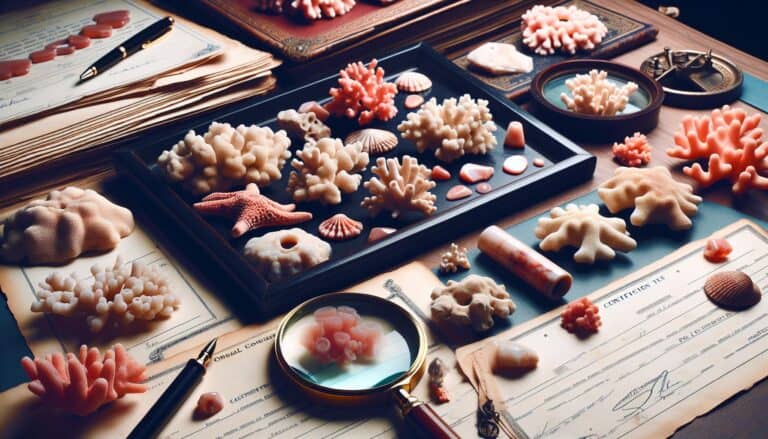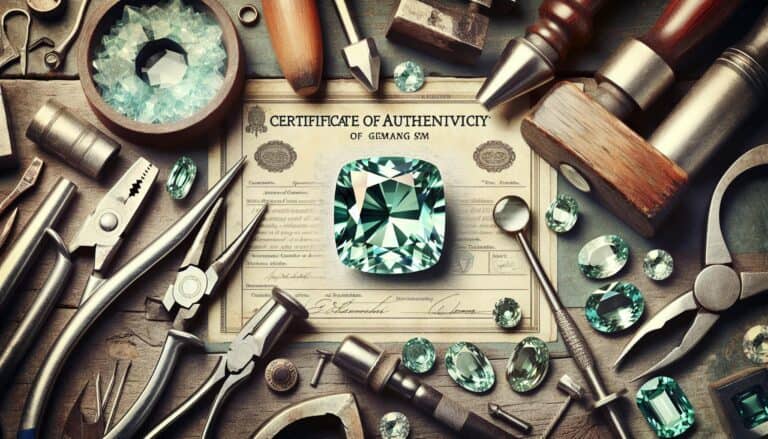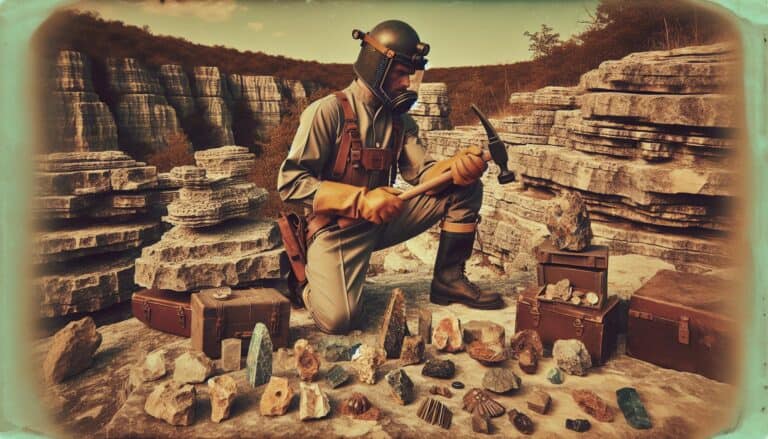Discovering the secrets of moissanite can be like embarking on a treasure hunt.
You’re eyeing that brilliant sparkle, but is it a diamond or its doppelgänger, moissanite? Fear not, you’re about to become a gemstone detective.
Understanding the nuances that distinguish moissanite from other gems is key to making informed purchases.
Whether you’re a jewelry enthusiast or in the market for that special ring, knowing how to identify moissanite is a skill that’ll serve you well.
To identify moissanite, inspect for brilliant sparkle and double refraction. Moissanite leaves a grayish streak, is non-magnetic, and ranks 9.25 on the Mohs scale. It shows strong birefringence and has a refractive index of 2.65-2.69, with a specific gravity of 3.22.
How to Identify Moissanite Through Testing
As your journey into gemstone identification continues, understanding the methods to reliably distinguish moissanite from other gems is crucial. The following tests offer you practical ways to pinpoint these dazzling stones.
Visual Inspection
Begin by carefully inspecting the stone’s appearance, scrutinizing features such as luster and fire. Moissanite is known for its exceptional brilliance, which can surpass that of many diamonds. Watch for the double refraction of light; unlike other stones, moissanite often displays this unique characteristic. Look for telltale signs of moissanite, including needle-like inclusions which are rarely found in other gems.
The Streak Test
The streak test, straightforward yet informative, involves gently dragging your stone across an unglazed porcelain tile to observe the color of the streak it leaves. Moissanite tends to leave a grayish streak. While this test isn’t definitive, it can serve as an initial indicator.
Magnet Test
While not all synthetic gems are magnetic, conducting a magnet test can sometimes aid in identification. Moissanite typically does not react to magnets, so a magnetic attraction could indicate the presence of other elements or materials.
Hardness Test
Leverage the Mohs scale of mineral hardness to gauge where your stone stands. With a hardness of 9.25, moissanite is one of the hardest substances on Earth, just below diamond.
Birefringence Test
Moissanite displays birefringence or the splitting of light into two paths when it passes through the stone. Identify this by observing the stone under a magnifying tool; if you see double of the back facets, it’s likely moissanite.
Checking The Diaphaneity
Observe the gemstone’s transparency or translucency. Moissanite is typically very transparent, which can be a helpful identifying feature when coupled with other tests.
Single or Double Refraction
While diamonds exhibit single refraction, moissanite shows double refraction. To spot this, peer through the top of the stone (the table) and look for doubling of the facet junctions within the gem.
Refractive Index Test
Use a refractometer to measure the refractive index (RI), an objective method to distinguish moissanite. Moissanite has a RI of 2.65-2.69, quite distinctive from other gemstones.
Finding The Specific Gravity
Determine the specific gravity (SG) by using a hydrostatic balance or a heavy liquid test kit. Moissanite has an SG of 3.22, which differs from other similar-looking stones, making this a reliable method for identification.
Identifying Moissanites in the Field
When identifying moissanite in the field, look for its typical habitat. These gemstones are often found in and around kimberlite pipes or areas with ancient volcanic activity.
Recognizing Potential Moissanite Rocks
Potential moissanite-bearing rocks can be recognized by their association with certain geological settings, such as peridotites and eclogites. Familiarize yourself with these rock types, as well as the texture and color of rough moissanite, to improve your field identification skills.
Physical Characteristics of Moissanite

Moissanites flaunt a unique set of physical attributes that set them apart from other gemstones. Crucially, their crystalline structure imparts a brilliance and fire that often exceed that of diamonds. When you’re examining moissanite, its luster is notably brighter and more pronounced, with a fiery sparkle that’s hard to miss.
You’ll find these gemstones are exceptionally hard, ranking at 9.25 on the Mohs hardness scale, which positions them just below diamonds. This high hardness not only contributes to moissanite’s durability but also adds to its value as a gemstone that can withstand daily wear and tear.
Another key feature is the stone’s clarity. Moissanites are created in controlled environments, ensuring minimal inclusion or blemishes. Their synthetic nature means they often have a higher clarity than natural diamonds, where inclusions are more common.
- Brilliance: Exceptional sparkle
- Hardness: 9.25 on Mohs scale
- Clarity: High with minimal inclusions
When it comes to color, you’ll notice that moissanites can exhibit a range of hues. While most aim for a clear or colorless appearance, there can be subtle undertones of green, yellow, or gray, especially under intense lighting. It’s these unique shades combined with their refractive qualities that can sometimes help you distinguish moissanite from other gemstones.
By familiarizing yourself with these physical characteristics, you’ll enhance your ability to correctly identify moissanite. Remember, its distinct shine, hardness, and visual properties are your primary clues.
How Are Moissanite Formed?
Moissanite crystals are born from a truly cosmic origin. Discovered in 1893 by Dr. Henri Moissan, the gemstone’s precursor was found in a meteor crater, revealing that moissanite comes from the stars. Initially mistaken for diamonds, these crystals are made of silicon carbide, a substance rare on Earth but abundant in space.
The Lab-Grown Advantage
You don’t have to wait for a meteor to witness the beauty of moissanite. Thanks to advanced technology, scientists are able to replicate the natural formation of moissanite in laboratories. Thermal Growing Process or Chemical Vapor Deposition methods mimic the conditions that create moissanite in nature, leading to the creation of these stunning gems.
- Thermal Growing Process: Mimics the high-pressure, high-temperature conditions in nature.
- Chemical Vapor Deposition: Involves breaking down gases to deposit silicon carbide.
By understanding the creation process, you get a glimpse into the meticulous effort behind every moissanite stone. The result is a gem that’s not just environmentally friendly but also exhibits the same structural integrity as its natural counterpart. Lab-grown moissanite offers the clarity and resilience that jewelers and consumers value.
The presence of silicon carbide is key to the gem’s durability and allure. While naturally occurring moissanite is exceedingly rare, the controlled environment of a lab allows for the production of high-quality crystals consistently. Each piece of lab-created moissanite is cut and polished to optimal standard ensuring that the stones you come across exhibit top-notch quality and brilliance.
Preparation for Moissanite Hunting
Gathering the Right Tools
To embark on your quest for the perfect moissanite, you’ll need to arm yourself with the right tools. Jeweler’s loupe is a must-have; its magnifying capabilities will help you differentiate moissanite from other gemstones. You should also consider investing in a moissanite tester, a device specifically designed to distinguish moissanite from diamonds through its electrical conductivity.
Keep a gemstone weight scale handy to measure the carat weight accurately, as moissanite stones are generally lighter than diamonds of the same size. Don’t forget a pair of tweezers or a gem holder; they’ll assist you in handling the stones without leaving fingerprints or residues. Essential for analysis, make sure you have a clean, well-lit workspace to view the stones correctly.
- Jeweler’s loupe
- Moissanite tester
- Gemstone weight scale
- Tweezers or gem holder
Remember, precision tools result in accurate identification, which is key in determining the true value of moissanite.
Safety Considerations
When hunting for moissanite, it’s paramount to prioritize safety, especially if you’re visiting mining sites or dealing with equipment. Protective eyewear is non-negotiable to guard your eyes from any flying debris while examining or handling stones. Ensure you’re wearing gloves to protect your hands from sharp edges and potential skin irritation from prolonged exposure to silicon carbide dust.
Always check that your tools are in good condition before use to avoid accidents. If you’re in a professional setting, abide by all set safety protocols and understand the proper use of your testing devices. Be mindful of your surroundings, particularly if you are purchasing from unfamiliar sources or in outdoor markets where crowds can pose a safety risk.
- Protective eyewear
- Durable gloves
- Regular tool maintenance
- Adherence to safety protocols
Maintaining a focus on safety not only protects you but also ensures a pleasant and successful moissanite hunting experience.
Handling and Care of Found Moissanite

Once you’ve successfully identified a moissanite, the next steps are crucial to maintain its brilliance and value. Proper handling and care will keep your stones looking their best and ready for further examination, sale, or setting.
Cleaning Moissanites
Handling your moissanite with care is essential to prevent smudging or transferring oils from your fingers onto the gemstone. Before cleaning, ensure your workspace is clean and free from dust. Equip yourself with a soft, lint-free cloth and mild soap. Use lukewarm water to create a soapy solution, and avoid harsh chemicals that could damage the moissanite’s luster.
- Gently brush the moissanite with a soft-bristled toothbrush.
- Dip it in the soapy water, and then rinse under warm water.
- Pat it dry with a lint-free cloth.
Avoid using steam cleaners or ultrasonic jewelry cleaners unless you’re sure they’re safe for moissanites. These methods can sometimes cause damage to stones if not used correctly.
Storing Moissanites
Improper storage can lead to scratched surfaces or chipped edges, so it’s essential to store your moissanite correctly. Always wrap moissanites in soft cloth or place them in a padded jewelry box.
- Separate moissanites from other gemstones or jewelry to avoid scratches.
- If using a jewelry box with compartments, ensure each moissanite has its own space.
Temperature and humidity should be consistent as extreme variations can sometimes affect the durability of the stone. If you plan on transporting your moissanite, consider a specialized gemstone container that offers protection and security. Remember, taking the time to clean and store your moissanites properly will go a long way in preserving their value and beauty.
Conclusion: Confirming Moissanite is Real
You’ve now got the knowledge to distinguish moissanite from other gemstones and understand the importance of proper care.
Remember, the luster of your find is as much about its inherent qualities as it is about how you maintain it. Keep it clean with gentle soap and a soft brush, and store it carefully to protect its sparkle for years to come. With these tips, you’ll ensure your moissanite remains a dazzling part of your collection. Whether for personal enjoyment or as part of your business, the care you give to these gems reflects the care you take in all your endeavors.
Embrace the brilliance of moissanite and let it shine.







